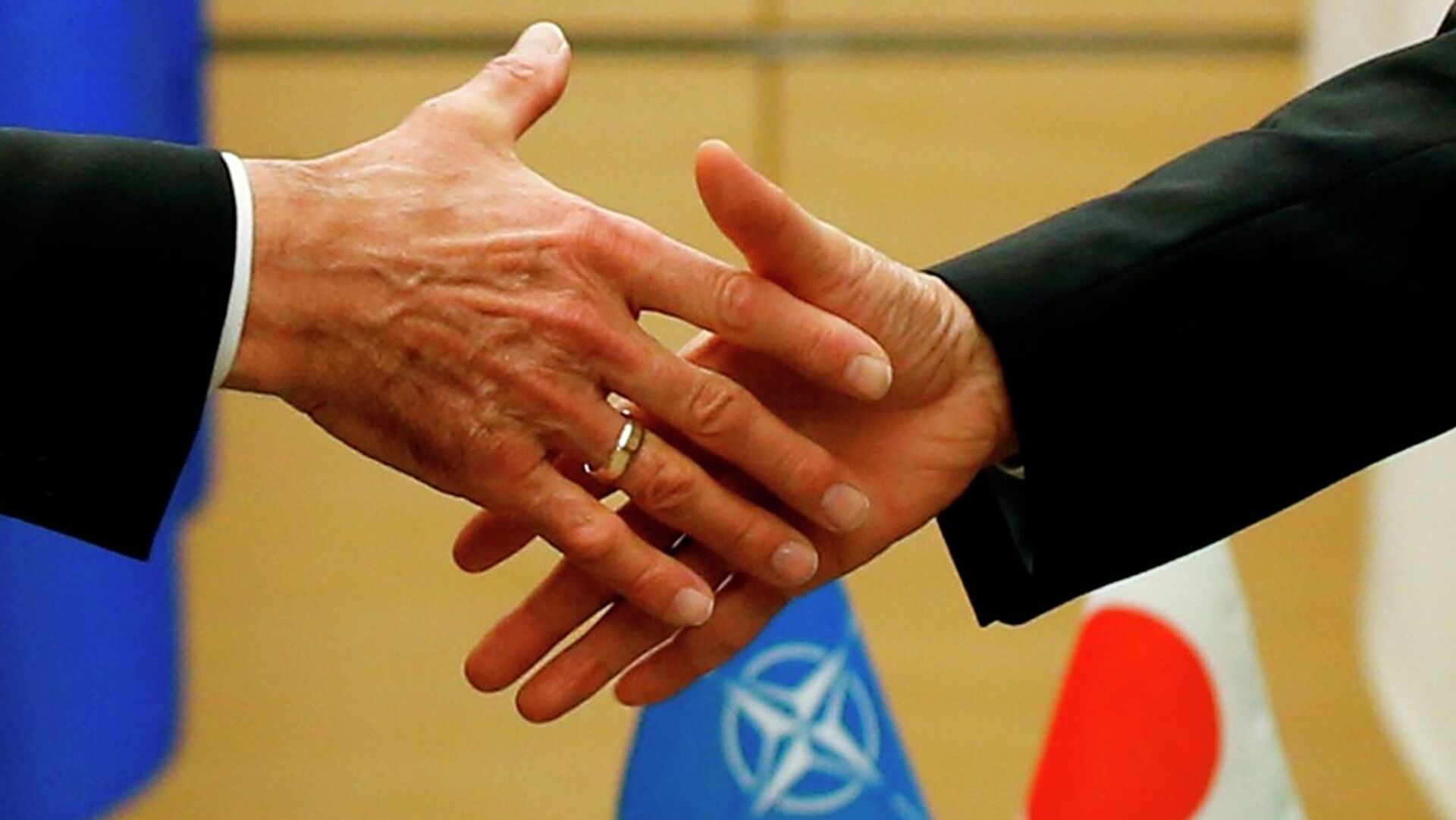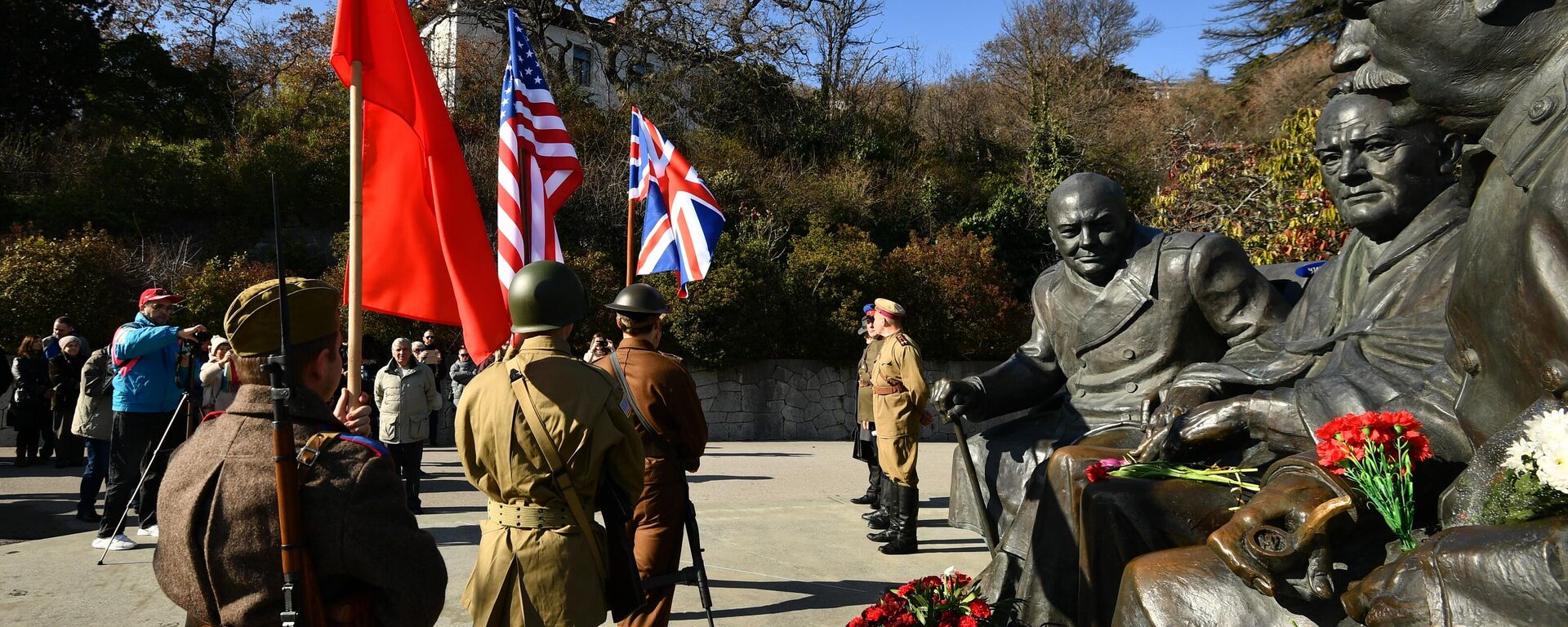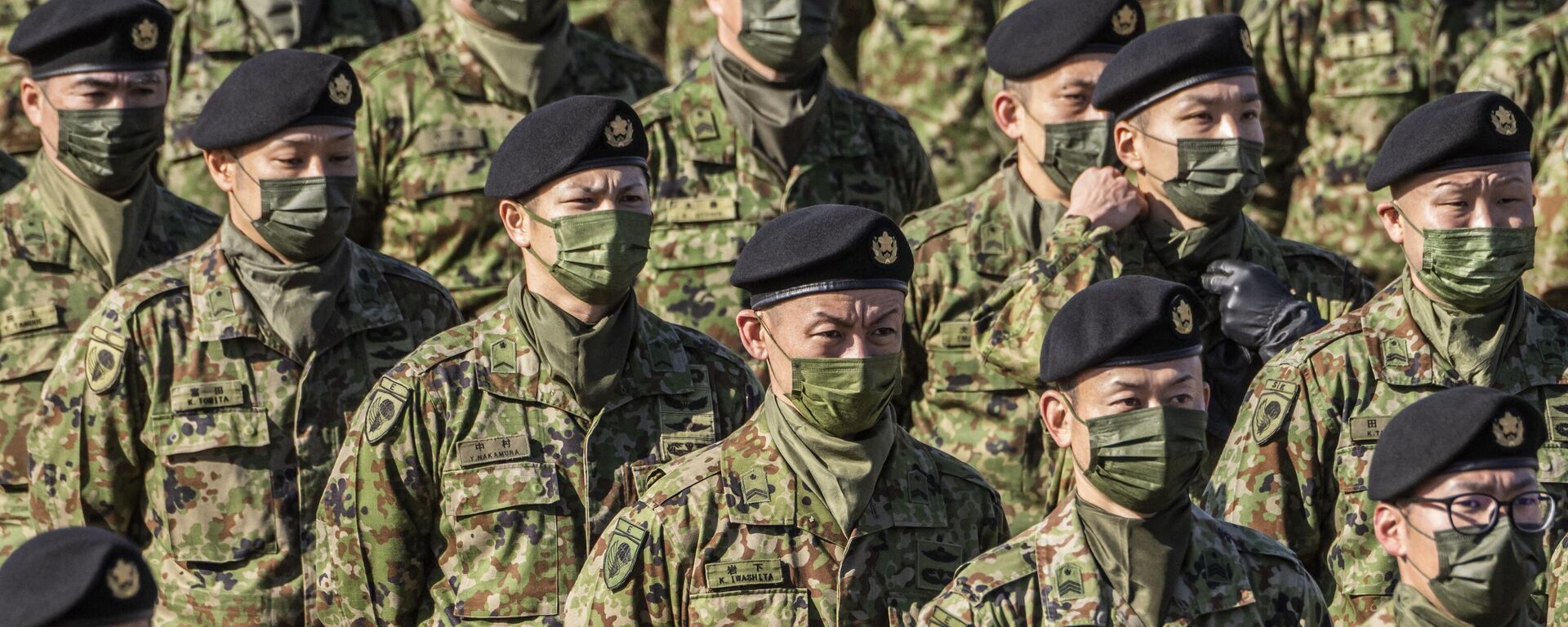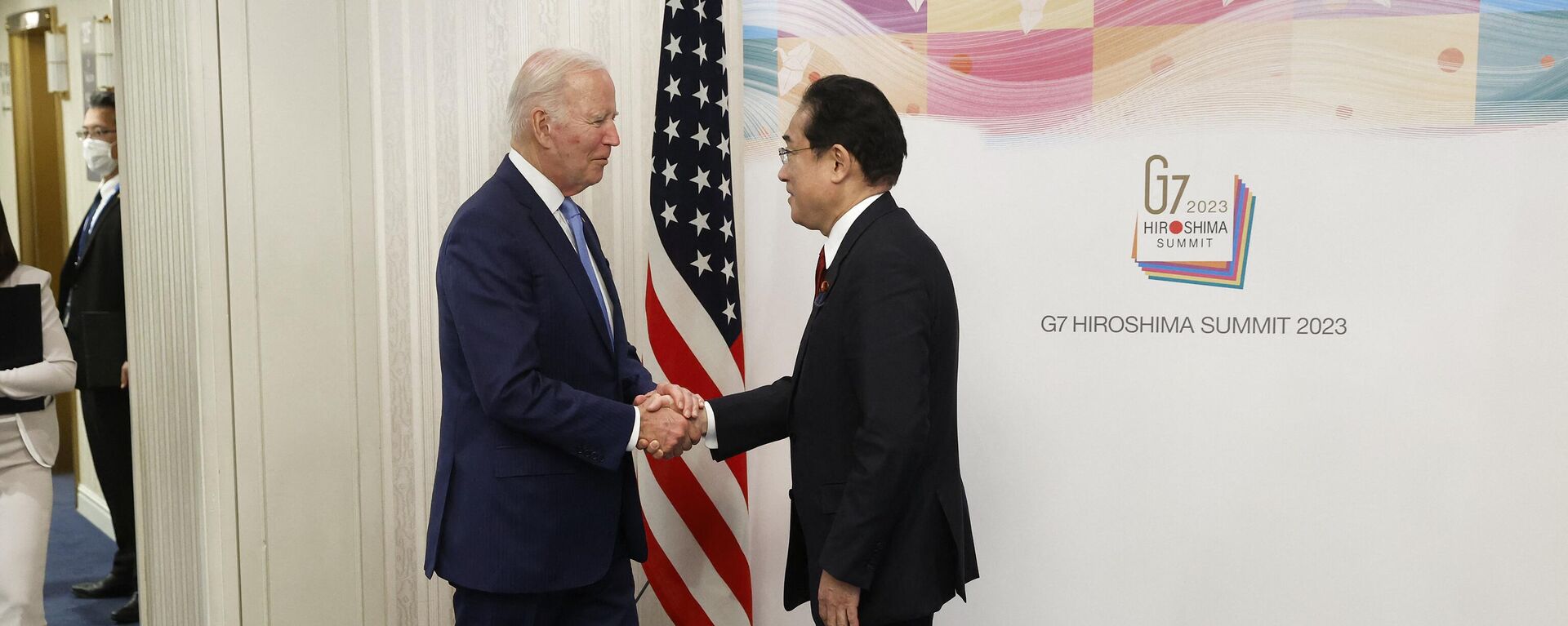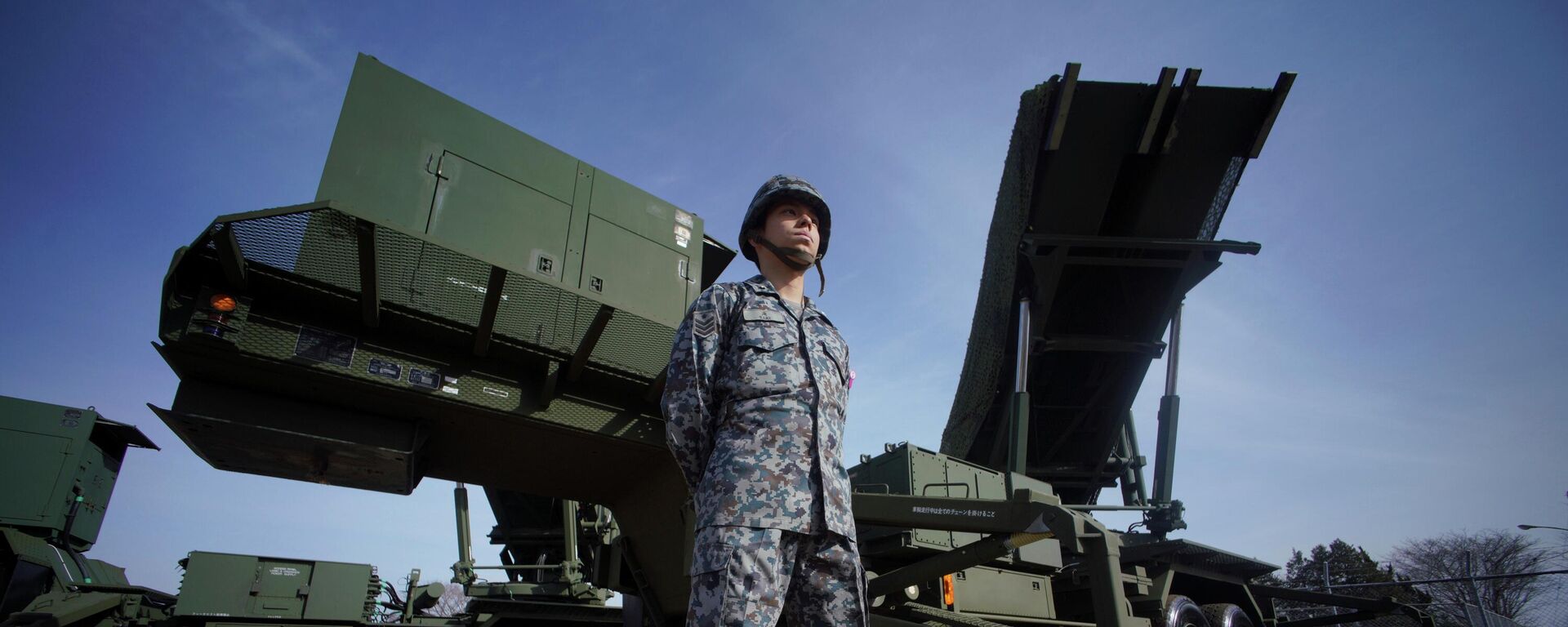https://sputnikglobe.com/20230630/all-fair-in-trade--war-japan-gambles-on-standardizing-weapons-with-nato--1111540977.html
All Fair in Trade & War? Japan Gambles on Standardizing Weapons With NATO
All Fair in Trade & War? Japan Gambles on Standardizing Weapons With NATO
Sputnik International
Japan's Defense Ministry has put forward a proposal to introduce Western standards for military technology, equipment, and weapons in Japan. The plan for the fiscal year 2024 budget is expected to be ready in August.
2023-06-30T13:26+0000
2023-06-30T13:26+0000
2023-06-30T13:30+0000
military
japan
japanese defense ministry
nato
nato expansion
https://cdn1.img.sputnikglobe.com/img/102460/70/1024607075_0:0:1024:577_1920x0_80_0_0_142ccd3119293f9a8ef8ad9ab9c4eed2.jpg
According to press reports, Japan's Ministry of Defense is alarmed by the escalating expenses associated with maintaining military equipment. To tackle this issue, they seek to enhance collaboration with allied nations in order to curtail these costs. The proposal crafted with precision leaves its implications open to interpretation.It was also mentioned that Japan's military-industrial complex, comprising over 9,000 companies engaged in tank, aircraft, and warship production, stands to benefit from increased export prospects. The Japanese government plans to relax restrictions on military goods exports, empowering defense industry companies to generate revenue through international sales.While the situation appears straightforward, there are underlying nuances that warrant attention.Unification for WarIn the realm of military endeavors, allied nations are forging a path towards unified combat proficiency through the standardization of equipment, weapons, and ammunition. This concerted effort aims to enhance joint participation in military operations by simplifying the logistical aspects of supplying troops, a paramount factor in the dynamic landscape of warfare.Standardization is key in military history. NATO has set the current standard for weapons, ammunition, and spare parts to ensure seamless participation of member countries in conflicts against the Cold War-era, USSR-led Warsaw Pact. The Warsaw Pact nations reciprocated, focusing on NATO conflicts and benefiting from the Soviet Union's substantial weapon supply and establishment of arms factories. Japan's military history also saw standardization, as allied states armed themselves with Japanese weaponry, including Type 38 rifles, Type 3 and Type 11 machine guns, Type 10 mortars, and Type 38 field guns.In essence, standardization serves wartime objectives, facilitating the merger of allied forces under a unified structure. Hence, if the Japanese Defense Ministry expresses its intentions to align its weapons and equipment with Western, namely, NATO standards, it potentially signifies a desire to integrate into the military bloc and potentially engage in future conflicts.Weapons Sales Standards, a Secondary MatterAn opportunity to trade arms is much more interesting, and Japan has the potential to become a significant exporter of military products without necessarily adopting NATO standards within its own army.Many military-industrial enterprises cater to customer requirements when producing military products. Furthermore, military equipment supply encompasses ammunition, spare parts, services, and support. Tank purchases typically include ammunition loads, where a set may entail rounds loaded into the tank.Spare parts follow a similar process, with tanks and aircraft procured alongside spare engines, consumables, maintenance tools, and instruments. Suppliers also provide training for mechanics in equipment repair and maintenance.However, serious doubts arise regarding the combat readiness of Japanese weapons and equipment with no involvement in wars since 1945 and a lack of combat testing in over 70 years. The main problem lies in the uncertainty surrounding whether Japanese weapons and military equipment can endure the demands of modern warfare.Hence, while standards hold secondary importance to customers, the primary concerns are reliability, combat readiness, and reasonable pricing of the equipment and weapons.NATO Membership as Military-Industrial BaseThe US and Russia dominate the arms export market, with their weapons having been extensively used in global conflicts for the past 70 years. Thanks to this battle-tested track record, customers are assured of reliable weaponry. Additionally, combat experience drives technological advancement, prompting crucial adjustments and notable improvements.Real combat situations in Ukraine currently serve as an extensive testing ground, revealing the limitations of Western technology, exemplified by the rapid destruction of the formerly esteemed Leopard 2A6 tanks.Japan's lack of combat experience and heavy reliance on Western models weaken its position in the global arms market. Focusing on mastering the production of Soviet or Russian-origin weapons and technology could benefit Japanese companies, given the demand for such products.While manufacturing Kalashnikov rifles, T-72 tanks, or MiG-29 fighter jets is unrealistic, the Japanese Defense Ministry's proposal to facilitate military product exports suggests Japan's potential as a military-industrial base for NATO countries. This resolves issues such as meeting NATO standards and fulfilling the demand for diverse military products within the alliance. Consequently, Japan will inevitably become involved in supplying Ukraine's armed forces, directly or indirectly.In essence, Japan's integration into NATO's military structure, marked by the abandonment of its self-defense policy, will bear significant consequences for the country.
https://sputnikglobe.com/20230509/1945-to-202-world-on-the-precipice-of-a-new-global-realignment-1110177944.html
https://sputnikglobe.com/20230407/is-japan-plunging-ever-deeper-into-nato-1109200370.html
https://sputnikglobe.com/20230623/japan-piqued-as-biden-claims-credit-for-tokyos-ramped-up-defense-costs-1111412557.html
https://sputnikglobe.com/20230613/tokyo-mulls-postponing-defense-tax-hikes-to-fiscal-2025-or-later--reports-1111108376.html
https://sputnikglobe.com/20230603/is-us-dragging-japan-into-conflict-with-russia-and-china-1110876946.html
japan
Sputnik International
feedback@sputniknews.com
+74956456601
MIA „Rossiya Segodnya“
2023
Sputnik International
feedback@sputniknews.com
+74956456601
MIA „Rossiya Segodnya“
News
en_EN
Sputnik International
feedback@sputniknews.com
+74956456601
MIA „Rossiya Segodnya“
Sputnik International
feedback@sputniknews.com
+74956456601
MIA „Rossiya Segodnya“
japan's defense ministry, aukus, japan adopts nato standards, japan nato relations, japan nato status, japan nato partnership, japan joining aukus
japan's defense ministry, aukus, japan adopts nato standards, japan nato relations, japan nato status, japan nato partnership, japan joining aukus
All Fair in Trade & War? Japan Gambles on Standardizing Weapons With NATO
13:26 GMT 30.06.2023 (Updated: 13:30 GMT 30.06.2023) Japan's Defense Ministry has put forward a proposal to introduce Western standards for military technology, equipment, and weapons in Japan. The plan for the fiscal year 2024 budget is expected to be ready in August.
According to press reports, Japan's Ministry of Defense is alarmed by the escalating expenses associated with maintaining military equipment. To tackle this issue, they seek to enhance collaboration with allied nations in order to curtail these costs. The proposal crafted with precision leaves its implications open to interpretation.
It was also mentioned that Japan's military-industrial complex, comprising over 9,000 companies engaged in tank, aircraft, and warship production, stands to benefit from increased export prospects. The Japanese government plans to
relax restrictions on military goods exports, empowering defense industry companies to generate revenue through international sales.
While the situation appears straightforward, there are underlying nuances that warrant attention.
In the realm of military endeavors, allied nations are forging a path towards
unified combat proficiency through the standardization of equipment, weapons, and ammunition. This concerted effort aims to enhance joint participation in military operations by simplifying the logistical aspects of supplying troops, a paramount factor in the dynamic landscape of warfare.
Standardization is key in military history. NATO has set the current standard for weapons, ammunition, and spare parts to ensure seamless
participation of member countries in conflicts against the Cold War-era, USSR-led Warsaw Pact. The Warsaw Pact nations reciprocated, focusing on NATO conflicts and benefiting from the Soviet Union's substantial weapon supply and establishment of arms factories.
Japan's military history also saw standardization, as allied states armed themselves with Japanese weaponry, including Type 38 rifles, Type 3 and Type 11 machine guns, Type 10 mortars, and Type 38 field guns.
In essence, standardization serves wartime objectives, facilitating the merger of allied forces under a unified structure. Hence, if the Japanese Defense Ministry expresses its intentions
to align its weapons and equipment with Western, namely, NATO standards, it potentially signifies a desire to integrate into the military bloc and potentially engage in future conflicts.
Weapons Sales Standards, a Secondary Matter
An opportunity to trade arms is much more interesting, and Japan has the potential to become a significant
exporter of military products without necessarily adopting NATO standards within its own army.
Many military-industrial enterprises cater to customer requirements when producing military products. Furthermore, military equipment supply encompasses ammunition, spare parts, services, and support. Tank purchases typically include ammunition loads, where a set may entail rounds loaded into the tank.
Spare parts follow a similar process, with tanks and aircraft procured alongside spare engines, consumables, maintenance tools, and instruments. Suppliers also provide training for mechanics in equipment repair and maintenance.
However, serious
doubts arise regarding the combat readiness of Japanese weapons and equipment with no involvement in wars since 1945 and a lack of combat testing in over 70 years. The main problem lies in the uncertainty surrounding whether Japanese weapons and military equipment can endure the demands of modern warfare.
Hence, while standards hold secondary importance to customers, the primary concerns are reliability,
combat readiness, and reasonable pricing of the equipment and weapons.
NATO Membership as Military-Industrial Base
The US and Russia dominate the arms export market, with their weapons having been extensively used in global conflicts for the past 70 years. Thanks to this battle-tested track record, customers are assured of reliable weaponry. Additionally, combat experience drives technological advancement, prompting crucial adjustments and notable improvements.
Real combat situations in Ukraine currently serve as an extensive testing ground, revealing the limitations of Western technology, exemplified by the
rapid destruction of the formerly esteemed Leopard 2A6 tanks.
Japan's lack of combat experience and heavy reliance on Western models weaken its position in the global arms market. Focusing on mastering the production of Soviet or Russian-origin weapons and technology could benefit Japanese companies, given the demand for such products.
While manufacturing Kalashnikov rifles, T-72 tanks, or MiG-29 fighter jets is unrealistic, the Japanese Defense Ministry's proposal to facilitate military product exports suggests Japan's potential as
a military-industrial base for NATO countries. This resolves issues such as meeting NATO standards and fulfilling the demand for diverse military products within the alliance. Consequently,
Japan will inevitably become involved in supplying Ukraine's armed forces, directly or indirectly.
In essence, Japan's integration into NATO's military structure, marked by the abandonment of its self-defense policy, will bear significant consequences for the country.
